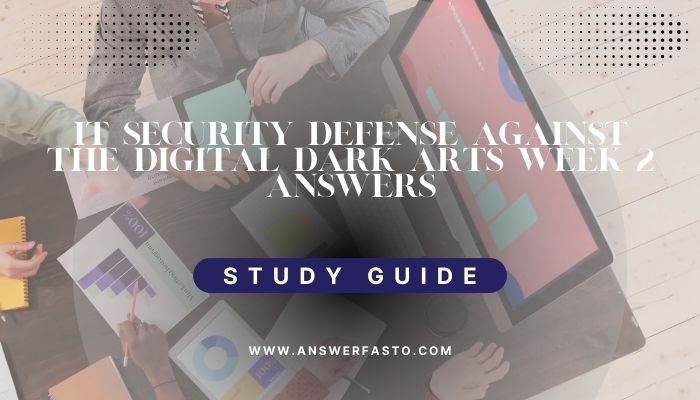1. What are the components that make up a cryptosystem? Check all that apply.
- Key generation algorithms
- Encryption algorithms
- Transmission algorithms
- Decryption algorithms
2. What is steganography?
- The practice of encoding messages
- The study of languages
- The study of stegosauruses
- The practice of hiding messages
3. What makes an encryption algorithm symmetric?
- High speed
- Very large key sizes
- Different keys used for encryption and decryption
- The same keys used for encryption and decryption
4. What’s the difference between a stream cipher and a block cipher?
- Stream ciphers can’t save encrypted data to disk.
- Stream ciphers encrypt data as a continuous stream, while block ciphers operate on chunks of data.
- Block ciphers are only used for block device encryption.
- There is no difference.
5. True or false: The smaller the encryption key is, the more secure the encrypted data is.
- TRUE
- FALSE
6. Which of the following do asymmetric cryptography systems provide? Select all that apply.
- Confidentiality
- Availability
- Authenticity
- Non-repudiation
7. What advantage does asymmetric encryption have over symmetric encryption?
- They have very fast performance.
- They allow secure communication over untrusted channels.
- They’re more secure.
- They’re easier to implement.
8. What’s a common application for asymmetric algorithms?
- Full disk encryption
- Secure password storage
- Secure key exchange
- Random number generation
9. What do we call a bit of information that allows authentication of a received message?
- Asymmetric encryption
- RSA
- Symmetric encryption
- MAC (Message Authentication Codes)
10. Which form of encryption does the US NEST recommend?
- NSA
- DSA
- EC
- DH
11. How is hashing different from encryption?
- Hashing operations are one-directional.
- It is less secure.
- It is faster.
- Hashing is meant for large amounts of data while encryption is meant for small amounts of data.
12. What is a hash collision?
- When two different files generate the same hash digest.
- When a hash digest is reversed to recover the original.
- When two identical files generate different hash digests.
- When two different hashing algorithms produce the same hash.
13. How is a Message Integrity Check (MIC) different from a Message Authentication Code (MAC)?
- A MIC only hashes the message while a MAC incorporates a secret key.
- They’re the same thing.
- A MAC requires a password while a MIC does not.
- A MIC is more reliable than a MAC.
14. How can one defend against brute-force password attacks? Check all that apply.
- Incorporate salts into password hashing.
- Run passwords through the hashing function multiple times.
- Enforce the use of strong passwords.
- Store passwords in a rainbow table.
15. ______ is a type of function or operation that takes in an arbitrary data input and maps it to an output of a fixed size, called a hash or a digest.
- Phishing
- A hash function
- Cryptography
- Secure key exchange
16. Which three of these pieces of information does a digital certificate contain?
- Identifying information of the certificate owner
- Public key data
- Private key data
- Digital signature
17. Which type of encryption does SSL/TLS use?
- Neither
- Both
- Asymmetric encryption
- Symmetric encryption
18. Which two of these are functions a TPM (Trusted Platform Module) can perform?
- Define the creation, storage, and distribution of digital certificates
- Malware detection
- Data binding and sealing
- Remote attestation
19. Which of these is a system that defines the creation, storage, and distribution of digital certificates?
- PKI
- CA
- DSA
- SHA-3
20. Which of these is a mechanism that lets you remotely connect a network or host to an internal private network while passing data over a public channel?
- IPsec
- L2TP
- VPN
- PGP
21. Plaintext is the original message, while _____ is the encrypted message.
- ciphertext
- algorithm
- digest
- cipher
22. The specific function of converting plaintext into ciphertext is called a(n) ______.
- integrity check
- encryption algorithm
- permutation
- data protection standard
23. Studying how often letters and pairs of letters occur in a language is referred to as _______.
- frequency analysis
- codebreaking
- espionage
- cryptography
24. The practice of hiding messages instead of encoding them is referred to as ______.
- obfuscation
- hashing
- encryption
- steganography
25. ROT13 and a Caesar cipher are examples of _______.
- substitution ciphers
- asymmetric encryption
- digital signatures
- steganography
26. DES, RC4, and AES are examples of ______ encryption algorithms.
- symmetric
- weak
- asymmetric
- strong
27. Which of the following are necessary components for encryption and decryption operations when using an asymmetric encryption system? Check all that apply.
- Public key
- Random number generator
- Digest
- Private key
28. To create a public key signature, use the ______ key.
- public
- private
- decryption
- decryption
29. Using an asymmetric cryptosystem provides which of the following benefits? Check all that apply.
- Non-repudiation
- Confidentiality
- Hashing
- Authenticity
30. If two different files result in the same hash, it is referred to as a ________.
- key collision
- hash collision
- coincidence
- mistake



